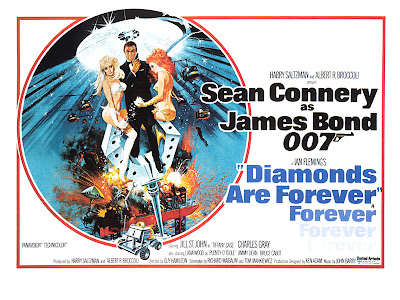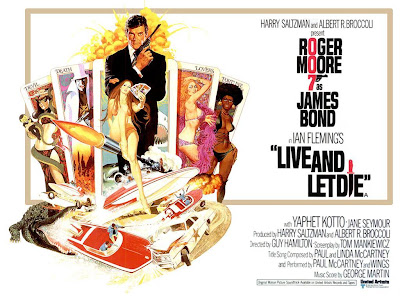Blaxploitation
More Bond: Double bill DaF & L&LD
Diamonds Are Forever

After the disappointment of On Her Majesty’s…, I expect everyone was as glad as me to see Sean Connery resuming Bond duties, taking the role back from Lazenby for one last Bond film. I had hazy memories of Diamonds Are Forever being - as well as one of the better titled Bonds - one that I’d particularly enjoyed. Sadly, it seems I was getting my Bond films confused: DaF is a pretty dull outing, really.
I’ll give the creators some credit: the henchmen are pretty creepy. Mr Kidd and Mr. Wint march around killing off a variety of implausibly trusting truck drivers and smugglers. It’s more than can be said for Blofeld, though, who makes a fairly pathetic villain here. There’s none of the mastermind threat that he had in earlier films: it seems that in each appearance he moves another step towards Dr Evil…
Most of all it isn’t that DaF is bad in any real sense (at least no more bad than other Bonds) but that it’s not a lot of fun. Bond just isn’t serious or important enough to get away with being boring. Even the quiet bits are supposed to be fun. Lurching between explosions, fights, car-chases, innuendo-laden chitchat and sex scenes Bond films are supposed to rattle along at a pretty relentless pace. Sadly DaF is just a little too slow. The climactic show-down just sees Bond gently bashing Blofeld’s submarine against a wall… Even Lazenby had a helicopter-attack-on-mountain-fortress payoff! This one’s just too tame. And not even Shirley Bassey can rescue it from that.
**Live and Let Die **

**L&LD can be accused of many things but it’s certainly not boring. It’s almost as if, face with reinventing Bond in a Roger Moore shape, the producers just decided to throw all sorts of fun at the film and see what stuck. **
It obviously cashes in heavily on the then-popular blaxploitation trend (just two years after Shaft!). Too those unfamiliar with those films it might seem more racist than er… anything else: Bond has left genealogists in stuffy British boardrooms behind and is now traipsing through Harlem (and sticking out like a sore thumb). For a large part of the film it does seem worryingly like every single Black character might well be a baddie, which does get a little awkward. Eventually the goodie-baddie balance is restored somewhat so it’s definitely not racist, no, not at all, never. Hmm…
Either way, it’s a hell of a lot of fun. They just ramped everything up a bit. We have poisonous snakes, revolving walls, super-gadgets, speedboat chases, comic characters. This is perhaps the first Bond film that feels really self-referential - it verges on the edge of pastiche at times - but for the most part it carries it well, staying just the right side of the line.
The ‘comic’ sheriff was a mistake though: a Southern States, gum-chewing, noisy, moron character played for laughs, it’s hard not to wince at each appearence he makes. Mercifully, his role is only brief, and it is intercut with the pretty-awesome speedboat chase. The producers made no such mistake with the villains though: claw-handed henchman Tee-Hee, snake-wielding face-painted Baron Samedi and the mastermind-villain-who-relies-on-Tarot-cards Kananga make a pretty formidable bad-guy line-up. Even if they do repeatedly fall for the classic mistake of explaining their entire plan first and then leaving Bond to die and looking away as he escapes…. But we can’t all be perfect.
L&LD ushers in the Moore era which, if I remember rightly, brings with it a fair number of pretty awful films but, in itself, is a pretty mad and fun Bond movie.
Super Bad, Super Cool and the Rise and Fall of the OST
I’ve just finished listening to a really rather wonderful BBC Radio 2 programme called Super Bad, Supe Cool about the phenomenon of the Blaxploitation film.
The hour long show was narrated by Pam Grier (star of Coffy, Foxy Brown and many a great film, described by Tarantino as being probably the first female action star). It delved into several aspects of the genre - from the controversial and much disputed title ‘blaxploitation’, it’s impact and significance for black actors and cinema-goers of 70s USA and the importance of the soundtrack in these films. Calling on a whole host of film and music luminaries from Isaac (RIP) Hayes (if you’re young, you probably know him best as South Park’s Chef) to Samuel L Jackson to Tarantino, Pam Griers examined the massive impact of cult-classic Shaft and it’s lasting influence on cinema.

I can’t add much to the show in terms of genre studies; you’d be much better seeking it out yourself. Sadly the 7 day listen-again feature on bbc iplayer has expired but it’s floating around the internet for anyone tech-savvy enough to find it.
Perhaps the most interesting element of the show in general cinema terms was the aspect of the soundtrack; Shaft is credited as having changed the way in which music and film were considered as complementary cultural works; many of the blaxploitation films were sold on little more than the fabulous soundtracks that accompanied them. Whilst the film score was an established form - see Mr Morricone for more details… - this was the first real example of the stand-alone pop song being created especially for cinema.
The soundtracks to these films were pop albums in their own right; someone interviewed on the show recalls the 12" records of the soundtrack being given away as promotional tools for the films and then later outstripping film sales.
Nowadays this is something of a lost art; in the digital age songs are made to be recognisable, to be sold as singles, and you are far more likely to find a film soundtrack cd that comprises of a series of hit singles by pop and rock bands, lifted from albums for the film, rather than recorded specifically for the film.
The film score still exists, by all means: just look at John Murphy’s excellent 28 Weeks Later score (and yes, though 28 days is the better film, it’s 28 weeks that has the more thorough soundtrack), but it would seem that the pop/rock one-artist Original Sound Track has been largely forgotten.
So let’s go repay a visit to the Shaft tune and remember better, funkier times: